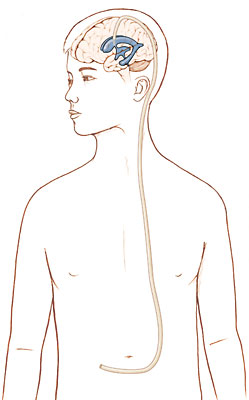Discharge Instructions for Hydrocephalus (Pediatric)
Discharge Instructions for Pediatric Hydrocephalus Following Shunt Placement
Your child has been diagnosed with hydrocephalus, a condition in which extra fluid builds up in the brain. This condition is sometimes referred to as “water on the brain.” The most common treatment for hydrocephalus is insertion of a shunt. This tube drains fluid from the brain to another space in the body, where it can be safely absorbed. Here's what you need to know about home care.
Home care
Give your child pain medicines as your healthcare provider directs.
Feed your child his or her regular diet.
Wash your child’s incision each day with mild soap. Rinse the incision with water and gently pat it dry.
Don’t allow your child to soak in water (in the bathtub or swimming pool) until the incision is completely healed.
Allow your child to resume normal activities gradually after returning home.
Be aware that if your child needs an MRI, the newer shunts are MRI compatible. Check with your healthcare provider to be sure.
Follow-up
Make a follow-up appointment, or as advised.
When to call your healthcare provider
Call your healthcare provider right away if your child has any of the following:
High-pitched cry or increased irritability
Trouble with sucking, drinking, or eating
Fever (see Fever and children, below)
Stiff neck (refusing to bend or move the neck or head)
Trouble breathing
Seizures
Head injury
Headache or visual disturbance
Bleeding, drainage, or pus at the incision site
Vomiting or stomach pain
Confusion or more than usual sleepiness
Fever and children
Always use a digital thermometer to check your child’s temperature. Never use a mercury thermometer.
For infants and toddlers, be sure to use a rectal thermometer correctly. A rectal thermometer may accidentally poke a hole in (perforate) the rectum. It may also pass on germs from the stool. Always follow the product maker’s directions for proper use. If you don’t feel comfortable taking a rectal temperature, use another method. When you talk to your child’s healthcare provider, tell him or her which method you used to take your child’s temperature.
Here are guidelines for fever temperature. Ear temperatures aren’t accurate before 6 months of age. Don’t take an oral temperature until your child is at least 4 years old.
Infant under 3 months old:
Ask your child’s healthcare provider how you should take the temperature.
Rectal or forehead (temporal artery) temperature of 100.4°F (38°C) or higher, or as directed by the provider
Armpit temperature of 99°F (37.2°C) or higher, or as directed by the provider
Child age 3 to 36 months:
Rectal, forehead (temporal artery), or ear temperature of 102°F (38.9°C) or higher, or as directed by the provider
Armpit temperature of 101°F (38.3°C) or higher, or as directed by the provider
Child of any age:
Repeated temperature of 104°F (40°C) or higher, or as directed by the provider
Fever that lasts more than 24 hours in a child under 2 years old. Or a fever that lasts for 3 days in a child 2 years or older.
Updated:
April 28, 2018
Sources:
Hydrocephalus in Children: Managemennt and Prognosis, Up To Date
Reviewed By:
Fetterman, Anne, RN, BSN,Shelat, Amit, MD
